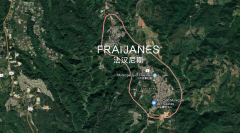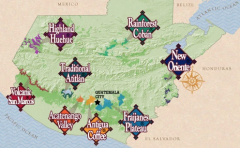A brief history of Guatemalan coffee grading system and flavor characteristics of Guatemalan coffee
A Brief History of Coffee in Guatemala
"Republic of Guatemala," commonly known as Guatemala, also means "a place with many trees." Geographically located in Central America, the Pacific Ocean to the west, the Atlantic Ocean to the east, Mexico to the north, Honduras and El Salvador to the southeast.
Guatemala is located in Central America and is the sixth largest coffee producer in the world. Coffee has always been the economic lifeline of Guatemala. Half of the domestic workforce is agricultural workers. Guatemala has a total of eight coffee-producing areas, with tropical rain forests, volcanic geology, plateau vertical valleys, and adjacent Atlantic and Pacific oceans interwoven with more than 300 micro-climates, thus creating unique flavors of different regions. Among them, Antigua and Highland Huehue coffee is the most famous. Arabica coffee beans are grown because of the unique climate, good fruit acid and multi-level rich flavor greatly praised. coffee grown mostly in Guatemala and graded according to altitude and treated mostly with water.
Coffee trees were introduced to Guatemala in 1750, coffee became an important cash crop there in 1845, and German colonists developed the coffee industry here at the end of the 19th century. Today, most of the coffee industry is produced in the south of the country. The slopes of Mount Madre provide ideal conditions for growing fine coffee beans, and coffee grown at high altitudes thrives. Critics prefer this blend of flavoured coffee with a spicy flavour to other types of coffee. The extra-hard coffee beans here are rare good coffee, it is full of particles, delicious, balanced acidity. Guatemala has also received attention for its giant coffee beans. The coffee industry, which once prospered the country, still dominates the national economy. Unfortunately, however, the political situation at home is not conducive to coffee growers. High output is usually a sign of overall economic prosperity in a country.

Guatemala coffee grading system
Prime: Planted at altitudes of 750 - 900 m.
Extra Prime: Planted at altitudes of 900 - 1050 m.
Semi Hard Bean: Planted at altitudes of 1050 - 1220 m.
Hard Bean (HB): Planted at an altitude of 1220 - 1300 m.
Strictly Hard Bean (SHB): Grown above 1300 meters.
Guatemala Flavor Features
Guatemala coffee flavor million kinds, multi-dimensional rich tonality, there are fine, elegant, sweet, fruity, but also more complex, rich, with chocolate, toffee aroma.

Important Notice :
前街咖啡 FrontStreet Coffee has moved to new addredd:
FrontStreet Coffee Address: 315,Donghua East Road,GuangZhou
Tel:020 38364473
- Prev

Geographical and climatic characteristics of Fahannis coffee producing area in Guatemala the tonality of French Hannis coffee
The Fahannis region is characterized by volcanic pumice soil, high elevations, heavy rainfall, changes in humidity and active volcanoes. The volcanoes around the Fahannis area are quite high above sea level, so that the Farrakhan Plain is still an active volcanic area, and the soil is rich in pumice, so the geographical environment of this producing area is similar to that of Antigua. However, the differences
- Next

Introduction to the New Oriental Coffee Bean producing area in Guatemala the flavor characteristics of Guatemalan coffee beans
New Oriental production area New Oriental production area is located in the southeast of Guatemala, along the way you will drive through the desert climate and see desert hills like Texas in the United States. It is a 5-hour drive from the capital to the New Oriental region at an altitude of 1300-1700m. It's located in El Salvador and Honduras.
Related
- Beginners will see the "Coffee pull flower" guide!
- What is the difference between ice blog purified milk and ordinary milk coffee?
- Why is the Philippines the largest producer of crops in Liberia?
- For coffee extraction, should the fine powder be retained?
- How does extracted espresso fill pressed powder? How much strength does it take to press the powder?
- How to make jasmine cold extract coffee? Is the jasmine + latte good?
- Will this little toy really make the coffee taste better? How does Lily Drip affect coffee extraction?
- Will the action of slapping the filter cup also affect coffee extraction?
- What's the difference between powder-to-water ratio and powder-to-liquid ratio?
- What is the Ethiopian local species? What does it have to do with Heirloom native species?

